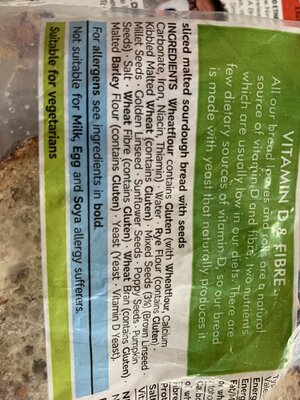- Joined
- Apr 30, 2005
- Messages
- 34,724
Below is snipped from here https://breadvillage.com/blogs/breadmeister-talk/why-sliced-bread-is-the-worst-invention-ever
Absolutely not, and we will explain why.
Sliced bread has been around for less than a century. The first automatically sliced commercial loaves were produced in 1928 in Missouri, using a machine invented by a guy from Iowa. The invention caught on, because consumers loved the convenience of sliced bread. But they weren’t told that this “progress” came at a high cost - akin to a deal with the devil - in the shape of big scale introduction of preservatives and additives into formerly pure bread.
The bread’s crust is very important for keeping moisture and flavor inside the bread loaf. Once the crust is cut, both disappear quickly. The bread slicers overcame this inconvenience - you guessed right - by stuffing the bread with preservatives.
How come sliced bread from grocery stores feels moist and doesn't get moldy, even though it’s been sitting on shelves for weeks? The answer is that it’s crammed with preservatives and chemicals.
Just take a look at the ingredient list on a typical loaf of sliced bread, which is truly remarkable:
Wheat Flour, Water, High Fructose Corn Syrup or Sugar, Yeast, Contains 2% or Less of: Ferrous Sulfate (Iron), B Vitamins (Niacin, Thiamine Mononitrate (B1), Riboflavin (B2), Folic Acid), Barley Malt, Soybean Oil, Salt, Calcium Carbonate (Ingredient in Excess of Amount Present in Regular Enriched White Bread), Wheat Gluten, Dough Conditioners (Sodium Stearoyl Lactylate, Mono and Diglycerides, Calcium Dioxide, Datem and/or Azodicarbonamide) Vitamin D3. Calcium Sulfate, Vinegar, Yeast Nutrients (Monocalcium Phosphate, Dicalcium Phosphate, Ammonium Sulfate, Ammonium Phosphate and/or Ammonium Chloride) Cornstarch, Wheat Starch, Soy Flour, Whey, Calcium Propionate (to Retain Freshness), Soy Lecithin.
Compare that to the ingredients in a loaf of authentic German artisan bread: Water, rye, wheat, salt, yeast, barley malt, spices. That's it! Simple and natural. The acid from rye sourdough acts like a natural preservative and keeps mold away. That made bread shelf stable when people had no fridges.
You be the judge: Which one do you think is better for you?
So, the next time someone tells you “this is the best since sliced bread”, you know better. If slicing bread seems like an effort, perhaps it helps to know that you are doing something good for your health. With a good bread knife and the right technique, slicing is easy: Saw gently back and forth with soft pressure cutting slices about 1/2" thick. Use the free hand to press the top of the crust together to avoid crumbling.
Enjoy!
Why Sliced Bread Is the Worst Invention Ever
The greatest thing ... sliced bread? Really?!Absolutely not, and we will explain why.
Sliced bread has been around for less than a century. The first automatically sliced commercial loaves were produced in 1928 in Missouri, using a machine invented by a guy from Iowa. The invention caught on, because consumers loved the convenience of sliced bread. But they weren’t told that this “progress” came at a high cost - akin to a deal with the devil - in the shape of big scale introduction of preservatives and additives into formerly pure bread.
The bread’s crust is very important for keeping moisture and flavor inside the bread loaf. Once the crust is cut, both disappear quickly. The bread slicers overcame this inconvenience - you guessed right - by stuffing the bread with preservatives.
How come sliced bread from grocery stores feels moist and doesn't get moldy, even though it’s been sitting on shelves for weeks? The answer is that it’s crammed with preservatives and chemicals.
Just take a look at the ingredient list on a typical loaf of sliced bread, which is truly remarkable:
Wheat Flour, Water, High Fructose Corn Syrup or Sugar, Yeast, Contains 2% or Less of: Ferrous Sulfate (Iron), B Vitamins (Niacin, Thiamine Mononitrate (B1), Riboflavin (B2), Folic Acid), Barley Malt, Soybean Oil, Salt, Calcium Carbonate (Ingredient in Excess of Amount Present in Regular Enriched White Bread), Wheat Gluten, Dough Conditioners (Sodium Stearoyl Lactylate, Mono and Diglycerides, Calcium Dioxide, Datem and/or Azodicarbonamide) Vitamin D3. Calcium Sulfate, Vinegar, Yeast Nutrients (Monocalcium Phosphate, Dicalcium Phosphate, Ammonium Sulfate, Ammonium Phosphate and/or Ammonium Chloride) Cornstarch, Wheat Starch, Soy Flour, Whey, Calcium Propionate (to Retain Freshness), Soy Lecithin.
Compare that to the ingredients in a loaf of authentic German artisan bread: Water, rye, wheat, salt, yeast, barley malt, spices. That's it! Simple and natural. The acid from rye sourdough acts like a natural preservative and keeps mold away. That made bread shelf stable when people had no fridges.
You be the judge: Which one do you think is better for you?
So, the next time someone tells you “this is the best since sliced bread”, you know better. If slicing bread seems like an effort, perhaps it helps to know that you are doing something good for your health. With a good bread knife and the right technique, slicing is easy: Saw gently back and forth with soft pressure cutting slices about 1/2" thick. Use the free hand to press the top of the crust together to avoid crumbling.
Enjoy!
Last edited:








300x240.png)